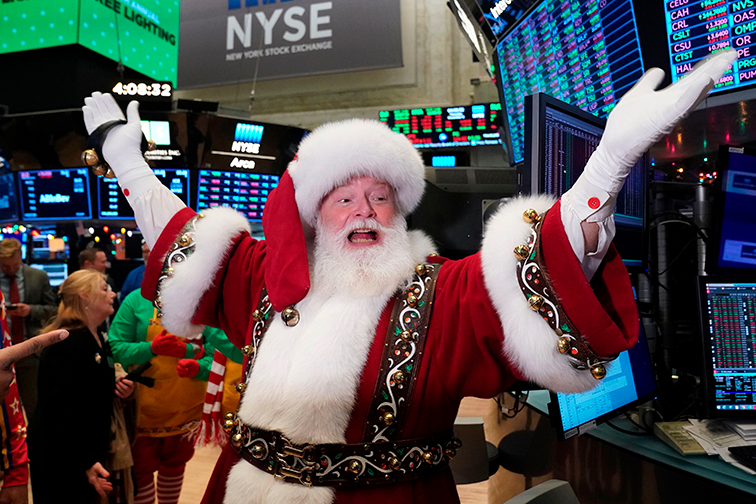
This article is taken from our FREE daily investment email Money Morning.
Every day, MoneyWeek’s executive editor John Stepek and guest contributors explain how current economic and political developments are affecting the markets and your wealth, and give you pointers on how you can profit.
It’s the most wonderful time of the year – if you’re a speculator, that is.
Not because it’s Christmas. But because Christmas means it’s time for the Santa Claus rally.
So what is the Santa Claus rally exactly? Does it work? And if so, how do we play it?
What is the Santa Claus rally (and do you really need me to explain it?)
Sometimes you find yourself explaining something that is self-explanatory. This is perhaps one of those times. The Santa Claus rally is a rally in stockmarkets, especially in the US, that occurs over Christmas – over the last weeks of December and into the first fortnight of January.
There are numerous explanations as to why it exists (and we will come to the question of whether it actually does exist in a moment).
There is of course the general feeling of good will and optimism that comes with Christmas (general elections notwithstanding). Many bonuses get paid at this time of year, and these are duly invested, pushing prices higher.
Some purists argue that the Santa Claus rally only begins in the last week of December, when sophisticated institutional investors have begun the winter break and the market is left in the hands of naive retail investors who tend to be much more bullish.
Are retail investors more bullish than institutional? Are they more naive? In some cases, yes, I suppose, but not always. In any case, that is the argument.
Tax considerations may also be a factor, as are people settling their books and getting positioned before the winter break.
Others buying in anticipation of the “January effect” – when stocks are also expected to go higher – may also be a factor. But if people are buying in late December in anticipation of a rise in January, that will surely lead to people buying in early December in anticipation of a rise in late December. And before you know it, the Santa Claus rally will be starting in November or October, and before you know it will be a summer phenomenon.
That said, there’s no official day that the Santa Claus rally begins. It’s much easier of course to identify Santa Claus rallies after the event than it is in real time, but the idea is to be looking for dips, buying them and then selling early in the new year.
The problem with this, of course, in that pretty much the entire investment world is looking for big dips in the lead up to Christmas, and so you often don’t get them. Or, as I say, they come earlier.
An early Santa Claus rally certainly seems to be the case this year. After a rocky first couple of days, we had a rip-roaring rally and markets currently seem to be consolidating and digesting those.
How to play the Santa Claus rally
Roughly two thirds of Decembers since 1969 have netted positive returns. But if we take a much more purist line, and consider that the Santa Claus rally only starts in the last week of December, with the “sell” coming in the first two days of January after new year, the Stock Traders’ Almanac has it that: “Since 1969, the Santa Claus rally has yielded positive returns in 34 of the past 45 holiday seasons … The average cumulative return over these days is 1.4%, and returns are positive in each of the seven days of the rally, on average.”
The normal way to play the Santa Claus rally is simply to buy the S&P 500. The Dow Jones and the Nasdaq will probably work as well.
However, perhaps a more appealing proposition is to go for the small-cap stocks, as these have a tendency to outperform. Research by Canadian technical analyst Ross Clark shows that in the last 40 years, buying the Russell 2000 Index (effectively the small-cap index) on 15 December and selling 11 trading days later, has been profitable 35 times. That’s an extraordinarily good hit rate.
15 December is this Sunday, so you could extend the trade a little on either side to this coming Friday or Monday.
Yet there is an even better option, says Clark, which is to refine the trade slightly. Wait for an entry point when the momentum indicator RSI is below 40, and the number of trades over the last 40 years is reduced to 23 – but only three of them are losing years.
Unfortunately, that doesn’t look like it will work for us this year, unless we get a sharp sell off this week. As you can see in the chart below, RSI is currently just below 70 (it’s actually at 63), so it would need something pretty brutal to take us down to 40 (indicated by the arrow).
But 35 out of 40 is still pretty good (indeed, not much different to 20 out of 23), so buying the small caps for a short-term bet looks reasonable.
This can be done via spreadbets, futures and options (all of which are only for those who know what they’re doing). The US-listed ETF, IWM, provides another, lower-risk option.
But the bottom line, however, is that US stocks are in a bull market, whether small cap or large cap. I have been beating this particular drum for a long time. Santa Claus rally or not, in a bull market you want to be long.
• Dominic’s new book Daylight Robbery: How Tax Shaped Our Past And Will Change Our Future, published by Penguin Business, is available at Amazon and all good bookshops. Audiobook at Audible.co.uk. Signed copies are available at dominicfrisby.com